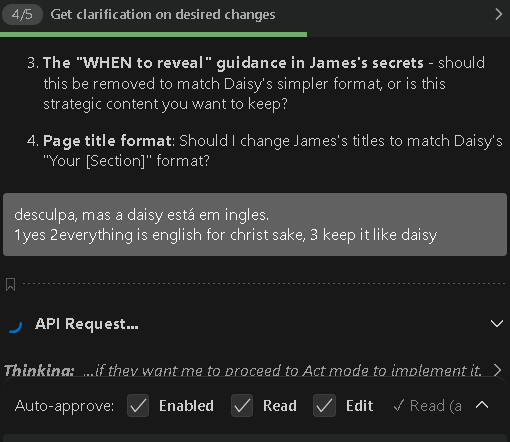Murder Mystery Bloopers: When AI Gets Creative (In the Wrong Way)
Murder Mystery Bloopers: When AI Gets Creative (In the Wrong Way)
Part of the Murder Mystery 1926 project
The Reality of AI-Assisted Creation
What people think building with AI looks like:
- Write prompt
- Get perfect result
- Ship it
What it actually looks like:
- Write prompt
- Get nonsense
- Adjust prompt
- Get different nonsense
- Google “why is AI like this”
- Generate 20 more variations
- Pick the least-broken one
- Call it “artistic vision”
This post is the nonsense part.
Blooper #1: The Piano Wire Incident
What I Wanted
The prompt:
Extreme macro close-up, broken piano wire approximately 30cm length coiled on dark wood surface (mahogany desk), wire diameter 0.8mm visible in sharp detail, dark brownish-red stains on sections of wire (dried blood implication), one end shows clean break with metal fiber separation visible, wire casts dramatic shadow from single key light above left, camera slow rotation orbit 270 degrees around wire over 6 seconds revealing different angles and stain patterns, slight movement as if wire has subtle life (micro-vibration), shot with 100mm macro lens f/2.0, ultra-sharp focus showing steel wire texture, color grading dark noir with cool blue tones, stains appear darker brown, photorealistic metal material and forensic detail, 8K macro, unsettling
In my head: Cinematic close-up. Noir lighting. Murder weapon vibes. Professional forensic aesthetic.
What I expected: Something like a CSI prop shot.
What I Got
My reaction:

What even IS that???
The AI:
- Understood “wire” ✅
- Understood “dark” ✅
- Understood “macro close-up” ❌
- Understood “forensic detail” ❌
- Understood “noir aesthetic” ❌❌❌
Result: A… thing. That moved. In ways piano wire should not move.
Usable? Absolutely not.
Entertaining? Extremely.
Blooper #2: The Character Portrait Phase
The Brief
What I needed: 11 character portraits in consistent 1920s style.
My process:
- Write detailed prompt
- Upload reference photo
- Generate
- Hope
Success rate: ~30%
Which means: I generated 30+ portraits to get 11 usable ones.
The Rejects
Common failures:
- Wrong era (suddenly in 1950s? 1800s? 2020s?)
- Wrong ethnicity (despite reference photo)
- Wrong gender (HOW?)
- Wrong expression (wanted mysterious, got constipated)
- Wrong clothing (tuxedo → clown suit???)
- Accessories appeared from nowhere (random monocles, top hats, Victorian collars)
The worst part: Sometimes it would nail 9 out of 10 details and mess up ONE thing catastrophically.
Example:
- ✅ Perfect 1920s suit
- ✅ Correct facial features
- ✅ Noir lighting
- ✅ Era-appropriate styling
- ❌ SIX FINGERS
My Frustration Timeline
Hour 1: “This is so cool! AI is amazing!”
Hour 3: “Why does everyone have weird hands?”
Hour 5: “I just need ONE more portrait. ONE.”
Hour 7:

Hour 9: “Fine. This one has slightly deformed ears but it’s GOOD ENOUGH.”
Blooper #3: The Video Tools Graveyard
Tools I tried on Fal.ai:
- Minimax → not quite right
- Kling → kinda close?
- Luma → no
- Runway → nope
- Various Sora alternatives → NOPE
Results: A folder full of unusable clips I paid real money for.
Current status of that folder: Exists. Mocking me. Reminding me of my poor financial decisions.
Will I ever delete it? No. It’s a monument to hubris.
The “Almost Good” Clips
Worst category: Clips that are almost perfect.
Like:
- 95% correct aesthetic
- 5% horrifying uncanny valley nonsense
Examples:
- Wine glass that melts mid-scene
- Hand that has too many knuckles
- Shadow that doesn’t match the object
- Background that shifts between 1920s and 1970s inexplicably
These hurt the most.
So close. Yet so unusable.
Blooper #4: The Ones I Loved But Couldn’t Use
Plot twist: Some AI outputs were TOO GOOD for the wrong reasons.
Example: Generated a clip that was:
- Absolutely gorgeous
- Perfect noir aesthetic
- Stunning cinematography
- Completely wrong for the scene I needed it for
Current status: Saved in a folder labeled “Future Projects (Maybe)”.
Will I use it? Probably not.
Will I keep it forever? Absolutely.
Blooper #5: Sound Design Adventures
Adobe Firefly for SFX.
What I needed:
- Door creaking
- Wine glass clinking
- Footsteps on wood floors
- Dramatic string music sting
Success rate: 70% (actually pretty good!)
But the 30%…
Requested: Door creaking ominously
Received:
- Door creaking ✅
- Followed by random cat meow ❌
- Why is there a cat ❌❌
- This is 1920s Manhattan not a pet store ❌❌❌
Usable? Technically yes, if I edited out the cat.
Did I? Yes.
Am I still confused? Also yes.
Blooper #6: The Gemini Voice Adventures
Gemini can generate voices.
I used it for character audio clips.
Success rate: 60%
Common problems:
- Wrong accent (wanted Transatlantic, got Australian???)
- Wrong tone (wanted mysterious, got cheerful infomercial host)
- Random pauses (mid… sentence… for… no… reason)
- Volume inconsistency (LOUD whisper QUIET SHOUT normal)
The weirdest one:
- Requested: 1920s femme fatale, sultry and mysterious
- Received: Exactly that… but the last word in every sentence sounded like a Pokemon
I don’t know why.
I still don’t know why.
It haunts me.
What I Learned from Failures
1. Generate WAY more than you need
My ratio: Generate 3-4x what you think you need.
Why:
- 30% will be unusable garbage
- 30% will be “technically fine but weird”
- 30% will be acceptable
- 10% will be actually good
Budget accordingly.
2. Detailed prompts help but don’t guarantee success
My piano wire prompt: 150+ words of technical detail.
Result: Weird moving blob thing.
Sometimes:
- More detail = better output
- Sometimes: More detail = AI gets confused and improvises chaos
No way to predict which.
3. AI has… opinions… about anatomy
Things AI struggles with:
- Hands (always)
- Fingers (specifically)
- Feet (surprisingly difficult)
- Ears (why???)
- The correct number of limbs
- How joints work
- The concept of “left” and “right”
Solution:
- Generate many variations
- Pick the least-broken one
- Hope nobody zooms in
4. “Almost perfect” is the most painful result
Bad output: Easy. Regenerate.
Good output: Easy. Use it.
95% perfect output with ONE glaring flaw:
Do you:
- Regenerate and risk not getting this close again?
- Use it and hope nobody notices?
- Manually edit it (if possible)?
- Cry a little?
Answer: All of the above.
5. Save the bloopers
Why:
- They’re entertaining
- They show the process
- They prove you’re human
- They make good blog content (hi!)
My blooper folder: 2.3 GB
Will I ever delete it? Absolutely not.
Is it organized? Absolutely not.
Do I regret anything? Only the money spent on Fal.ai.
The Silver Lining
Despite all these failures:
- ✅ The game got made
- ✅ The teaser video worked
- ✅ I learned a ridiculous amount
- ✅ I have hilarious bloopers to share
Building with AI is:
- 20% “wow this is magic”
- 30% “okay this is useful”
- 50% “WHAT IS HAPPENING”
But it works. Eventually. With enough patience. And backups. And budget.
For Other Builders
If you’re making something with AI generation:
Expect failures. Lots of them.
Generate extras. Way more than you think you need.
Save the weird ones. They’re proof of the process.
Laugh at the absurdity. It helps.
Keep iterating. Eventually you get results you’re proud of.
Document the chaos. It makes good content. (Like this post!)
The Final Product
Despite all the bloopers:
- 11 character portraits ✅
- 100+ pages of game materials ✅
- Teaser video ✅
- Sound design ✅
- Ready for December 25, 2025 ✅
Watch the (successful) teaser: Murder Mystery 1926 project page
Was it worth the chaos? Ask me after the event.
Part of the Artifactum series - Murder mysteries built with AI assistance (and a lot of trial and error).
See the final product: Murder Mystery 1926
Related posts:
- Why lm-arena beats Fal.ai
- Full video production pipeline (coming soon)
Got weird AI outputs? Share them! I want to see your bloopers too. Let’s normalize the chaos. 🎬🗑️
Comments